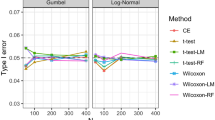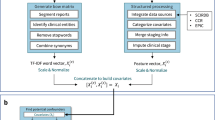Key Points
-
Explains the PICO statement and the basics of randomisation.
-
Readers will understand the basics of statistical testing, sample size calculations and the basics of bias.
-
Readers will also understand the role of Clinical Trials Units and why they are important when considering an experimental design
Abstract
This practical paper explains how to design an randomised controlled trial (RCT) for those who have little prior knowledge of the topic. It covers the basics of radomisation, statistical testing, sample size caluclations, bias and the role of Clinical Trial Units.
Similar content being viewed by others
Log in or create a free account to read this content
Gain free access to this article, as well as selected content from this journal and more on nature.com
or
References
Pawson R . The science of evaluation. London: Sage Publications, 2013.
Tickle M, O'Neill C, Donaldson M et al. A randomised controlled trial to measure the effects and costs of a dental caries prevention regime for young children attending primary care dental services: the Northern Ireland Caries Prevention In Practice (NIC-PIP) trial. Health Technol Assess 2016; 20: 1–96.
Clarkson J E, Ramsay C R, Averley P et al. IQuaD dental trial; improving the quality of dentistry: a multicentre randomised controlled trial comparing oral hygiene advice and periodontal instrumentation for the prevention and management of periodontal disease in dentate adults attending dental primary care. BMC Oral Health 2013; 13: 58.
Innes N P T, Clarkson J E, Speed C, Douglas G V, Maguire A, FiCTION Trial Collaboration. The FiCTION dental trial protocol filling children's teeth: indicated or not? BMC Oral Health 2013; 13: 25.
Hesse D, de Araujo M P, Olegário I C, Innes N, Raggio D P, Bonifácio C C . Atraumatic restorative treatment compared to the Hall Technique for occluso-proximal cavities in primary molars: study protocol for a randomized controlled trial. Trials 2016; 17: 169.
Schulz K F, Altman D G, Moher D, for the CONSORT Group. CONSORT 2010 Statement: updated guidelines for reporting parallel group randomised trials. BMJ 2010; 340: c332.
Bangor University. NWORTH remote randomisation system. Available at http://nworth-ctu.bangor.ac.uk/randomisation/index.php.en (accessed January 2017).
Hoare Z, Whitaker C J, Whitaker R . Introduction to a generalized method for adaptive randomization in trials. Trials 2013; 14: 19.
Russell D, Hoare Z S J, Whitaker R, Whitaker C J, Russell I T . Generalized method for adaptive randomization in clinical trials. Stat Med 2011; 30: 922–934.
Fisher R A . Presidential Address by Professor RA Fisher. Sankhyā. Ind J Statistics 1938; 4: 14–17.
Arain M, Campbell M J, Cooper C L, Lancaster G A . What is a pilot or feasibility study? A review of current practice and editorial policy. BMC Med Res Methodol 2010; 10: 67.
Lancaster G A . Pilot and feasibility studies come of age! Pilot Feasibility Stud 2015; 1: 1.
Eldridge S M, Lancaster G A, Campbell M J et al. Defining feasibility and pilot studies in preparation for randomised controlled trials: development of a conceptual framework. PLoS ONE 2016; 11: e0150205.
Lam A Y, Jorm A F, Wong D F . Mental health first aid training for the Chinese community in Melbourne, Australia: effects on knowledge about and attitudes toward people with mental illness. Int J Mental Health Systems 2010; 4: 18.
Chan A W, Tetzlaff J M, Altman D G . SPIRIT 2013 Statement: Defining standard protocol items for clinical trials. Ann Intern Med 2013; 158: 200–207.
Brady M C, Stott D, Weir C J et al. Clinical and cost effectiveness of enhanced oral healthcare in stroke care settings (SOCLE II): a pilot, stepped wedge, cluster randomized, controlled trial protocol. Int J Stroke 2015; 10: 979–84.
Brown C A, Lilford R J . The stepped wedge trial design: a systematic review. BMC Med Res Methodol 2006; 6: 54.
Woods B, Russell I . Randomisation and chance-based designs in social care research. Available at http://sscr.nihr.ac.uk/PDF/MR/MR17.pdf (accessed January 2017).
Schumi J, Wittes J T . Through the looking glass: understanding non-inferiority. Trials 2011; 12: 106.
Ellis P D . The essential guide to effect sizes: Statistical power, meta-analysis, and the interpretation of research results. Cambridge: Cambridge University Press, 2010.
Chan A W, Altman D G . Identifying outcome reporting bias in randomised trials on PubMed: review of publications and survey of authors. BMJ 2005; 330: 753.
Goldacre B . Bad science. Harper Collins: London, 2008.
UKCRC. Clinical Trials Units. Available at http://www.ukcrc-ctu.org.uk/?page=CTURole (accessed January 2017).
Legislation.gov. UK Medicines for Human Use (Clinical Trials) Regulations. Available at http://www.legislation.gov.uk/uksi/2004/1031/contents/made (accessed January 2017).
Martin-Kerry J M, Lamont T J, Keightley A et al. Practical considerations for conducting dental clinical trials in primary care. Br Dent J 2015; 218: 629–634.
Author information
Authors and Affiliations
Corresponding author
Additional information
Refereed Paper
Rights and permissions
About this article
Cite this article
Brocklehurst, P., Hoare, Z. How to design a randomised controlled trial. Br Dent J 222, 721–726 (2017). https://doi.org/10.1038/sj.bdj.2017.411
Accepted:
Published:
Issue date:
DOI: https://doi.org/10.1038/sj.bdj.2017.411



